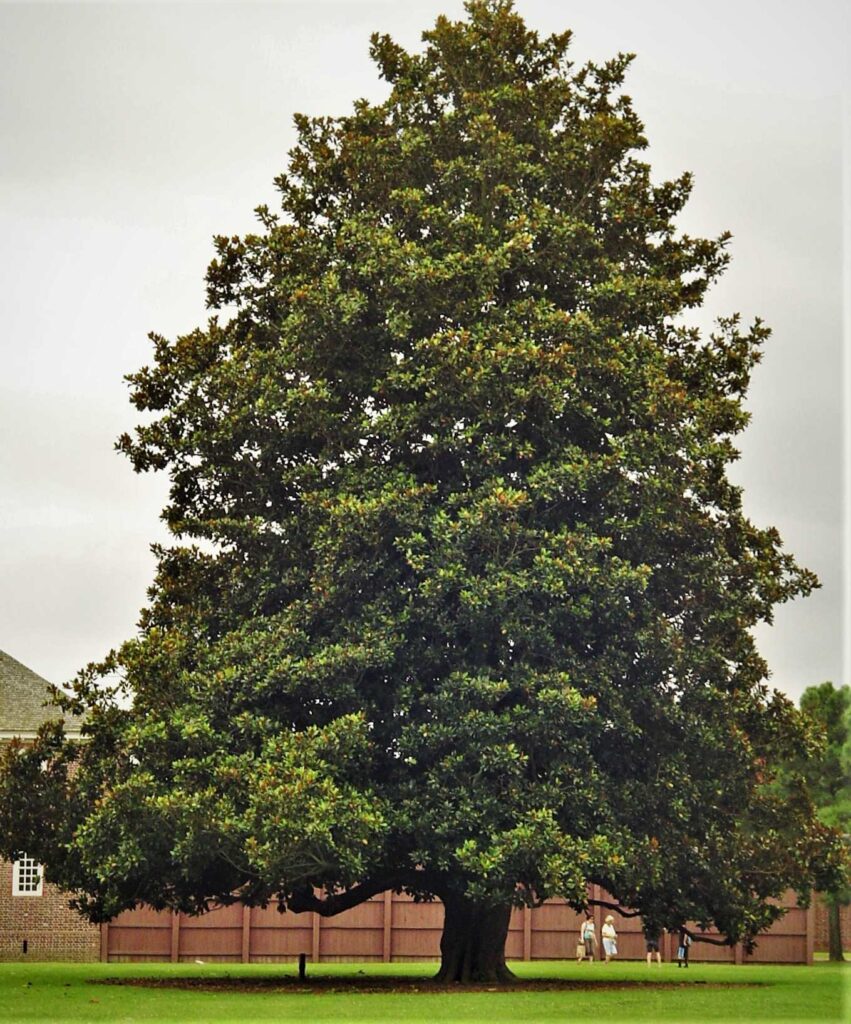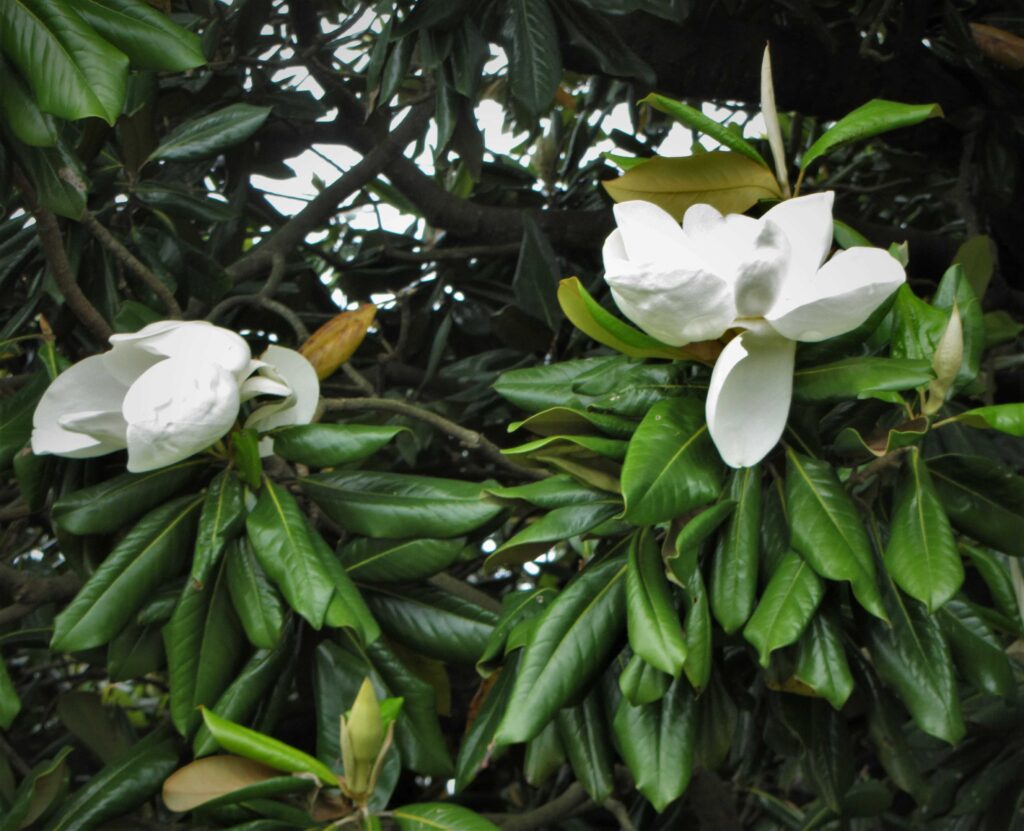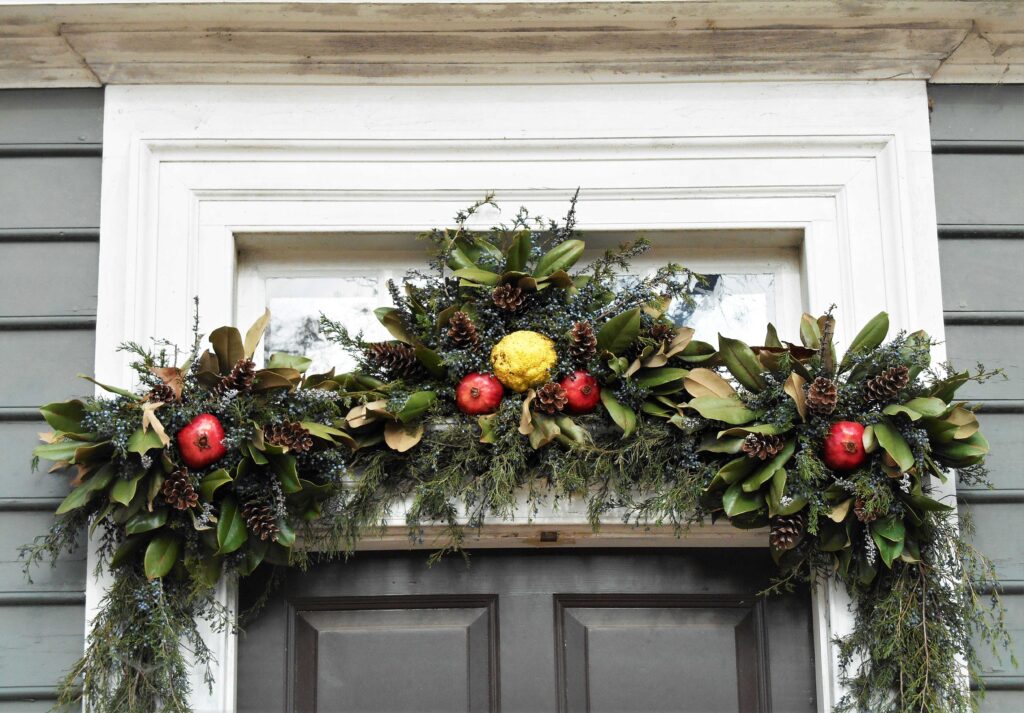The Regal Southern Magnolia
The sweet fragrance of Magnolia flowers on a warm breeze announces summer in Virginia. But that wasn’t the case 400 years ago, before European colonists began exploring for interesting tree species, transplanting them to new areas, and exporting them back to Europe. The original native range of Magnolia grandiflora is only from the Carolinas south to Florida and westwards towards Texas along the Gulf Coast. Our iconic Southern Magnolia trees aren’t indigenous in this region, but they have since naturalized along the Atlantic coast as far north as Delaware.

Southern Magnolia at Colonial Williamsburg. The oldest known Magnolia trees still growing on Colonial Williamsburg properties date to the early 19th Century.
Historical Horticulture
Early colonists interested in horticulture and botany, like John Bartram (1699-1777), a Quaker in Pennsylvania, traveled throughout the colonies in search of interesting plant species to ship to their contacts in England, Germany, Holland, and other parts of Europe. American species were highly valued because they were beautiful and novel. Many American species were hardy in England and Europe and could be grown outdoors rather than in hothouses.
Englishman Mark Catesby (1683-1749) visited Williamsburg with his sister, who was married to a colonial official, in 1712. He collected seeds and botanical specimens first in Virginia, later in Jamaica, and then throughout the Southeast in 1722-1726. He brought the first seeds for M. grandiflora back to England in 1726, and those trees finally bloomed by the 1750s. Southern Magnolia trees were introduced for sale in England by the mid- 1730s. It had already been introduced in France by this time. French explorers collected seeds in Louisiana, near the Mississippi River.
Seeds of American trees, shrubs, vines and flowers were grown by several dedicated English and European gardeners, who then propagated and sold specimens to an 18th Century gardening public eager to enjoy New World flowers and trees. Engravings of Magnolia flowers, drawn from trees he had seen during his travels, were published in England in Catesby’s Natural History of Carolina, Florida and the Bahama Islands, in several volumes, beginning in 1729.
The hardier M. virginiana, indigenous in Virginia and hardy in Zones 5-10, had already been introduced in England by English botanist and missionary John Bannister in 1678. Though sweetbay M. virginiana was enjoyed by many by the 1730s, English gardeners preferred the showier, evergreen M. grandiflora once it was introduced. Other North American Magnolia species include M. macrophylla, M. acuminata, M. tripetala and M. fraseri.

Sweetbay M. virginiana blooms at the Williamsburg Botanical Garden in late May and early June. Leaves are deciduous in colder climates, but may persist through the winter in warmer areas.
Historical Roots of Magnolia Trees
The genus Magnolia, named around 1703 for French botanist Pierre Magnol, includes between 200 and 300 species distributed primarily in North, South and Central America and in Asia. Magnolia is an ancient genus, with fossilized remains recognizable as Magnolias dated to 95 million years ago, before the appearance of bees. Magnolia flowers are designed to be pollinated by beetles, which explains why the flowers are so sturdy. This genus belongs to the family Magnoliaceae.

Sturdy, concave tepals may be used to hold ‘small bites’ of food. They are commonly used in some Asian cuisines.
Ethnobotany
Asian Magnolia species were grown not only for their beauty, but also for their medicinal properties. Leaves, flowers and bark were all used in traditional Asian medicine, and still are today. Magnolia petals are edible and may be used as garnishes for food and beverages, or to hold small portions of food served in each sturdy, concave tepal. They taste a bit like citrus and ginger, and may also be used as a seasoning in cooked dishes. Magnolia leaves are sometimes used to serve food in some cultures, though they are too tough and bitter to eat.

Magnolia trees line the path near a hotel in Colonial Williamsburg. It is unusual to see the bark and structural elements of Southern Magnolias. While most grow from a central trunk, some develop multiple trunks.
Native American were very familiar with the medicinal properties of American Magnolia species long before colonization. Magnolia bark, which is generally smooth and grey, has anti-microbial and anti-inflammatory properties. It was also used to treat circulatory disorders, depression, insomnia, stress and to aid digestion.
Characteristics of Southern Magnolia
Southern Magnolia, M. grandifolia, commonly grows to 80’ tall and 50’ wide in Zones 6 or 7 to 10. It’s large, thick, glossy evergreen leaves, to 10” long and 5” wide, last for two years, falling in spring as new leaves replace them, and again in autumn. They form a dense ground cover that is slow to decompose. The back of each leaf is covered with a velvety brown fuzz in many varieties. The tree blooms from late May with large, lotus-like creamy white flowers 8”-12” across, composed of waxy concave tepals. The flowers are scattered throughout the canopy. This is a magnificent, regal tree that shines like a beacon in the landscape.
Food and Shelter for Wildlife
Cone-like (non-edible) fruits, 3”-5” long, appear in late summer and early fall, revealing glossy red seeds as they ripen. Birds and other small animals eat the seeds. This dense tree provides shelter and nesting spots for wildlife.
The fallen fruits and leaf litter can require effort to clean up and dispose of. Often, they are left to decompose below the trees. This is a productive zone for birds foraging for insects. Lower branches continue to grow year to year and may touch the ground and take root, even on very large old trees. Some gardeners limb-up Magnolia trees to maintain the area beneath them.
Southern Magnolias Today
Southern Magnolia is naturalized throughout coastal and central Virginia now, and in many other parts of the United States. These iconic trees add elegance to the landscapes of many historic homes and gardens. Visitors to the Colonial Parkway and Jamestown Island will notice Magnolia trees mixed among other hardwood trees and conifers along the roadside, often growing in the shade. Since the trees seed themselves around, uncultivated trees may frequently be found in clusters, with seedlings in various stages of growth nearby. Homes in many neighborhoods have several different species and varieties of Magnolia trees as a part of their landscape. An individual tree can live for more than a century.

This historic and beautiful Magnolia grows along the Colonial Parkway between Colonial Williamsburg and Jamestown Island near an historic dairy farm that is one of the oldest farms in the country.
Recommended Varieties
There are more than 150 named M. grandiflora cultivars and varieties. Recent commercial introductions of M. grandiflora have produced smaller trees and varieties hardy as far north as Zone 5. Some will also rebloom throughout the summer. Some of the most popular varieties are relatively compact.
‘Bracken’s Brown Beauty,’ patented in 1985, is hardy to Zone 6, 5b with wind protection. Grows 30’-50’ tall and 15’-30’ wide with lustrous dark green and rusty brown leaves.
‘Claudia Wannamaker,’ a large oval form matures at 50’ or more tall.
‘Edith Bogue’ is extremely cold hardy, to Zone 6, and tolerates heavy, wet snows. Grows 30’-40’ tall and to 20’ wide with a more open habit than some varieties.
‘Hasse’ grows in a narrow, columnar form to 50’ tall and 18’ wide. It holds its tight form into maturity.
‘Little Gem’ leaves are smaller than some, to 4” long. Flowers are also a little smaller, to 5”, blooming over a long season from May through October. Grows to only 20’ tall and 10’ wide at maturity.
‘Teddy Bear’ is an upright, pyramidal tree with wavy, dark green leaves to 6” long. Grows to 25’ tall by 10’ wide. It is recommended for smaller properties.

Deer don’t eat Magnolia leaves, but may damage young trees by rubbing their antlers against their bark. This is a wild seedling tree dug from a neighbor’s yard. November 2013
An Adaptable, Useful, Easy to Grow Tree
Southern Magnolias have few pest or disease problems, tolerate wet soil, salt spray, and rarely sustain storm damage. Deer may damage young trees by rubbing on their bark, but do not graze the leaves.
These evergreen trees capture and sequester carbon and other pollutants, and produce oxygen, as they continue photosynthesis during the winter months. They frequently grow near wetlands and where the soil remains moist much of the year. This allows them to absorb groundwater and return it to the atmosphere continuously. Their extensive roots help to prevent soil erosion.

This is the same wild tree nearly 10 years later. The broken branch healed after being taped back in place and the trunk continued to grow around the scar. The tree has not yet bloomed, and may not bloom until it is at least 20 years old. It grows in part shade but enjoys rich, moist soil. May 2023
Magnolia trees are beautiful year-round. Their evergreen leaves and attractive cones are used in traditional holiday decorations. These trees provide dense, cooling shade in summer.

Magnolia leaves make a sturdy base for wreathes, swags, and other holiday decorations. Colonial Williamsburg Christmas decorations, 2015
Culture
Species Magnolias grow easily from seed in full sun to partial shade. Propagation from cuttings is more challenging as the cuttings generally require special handling and bottom heat. They tolerate many different types of soil so long as it is moist, even tolerating very acidic soil. They may self-seed and become weedy where there isn’t room to accommodate their mature growth. Trees grown in full sun produce more abundant flowers.
Before recent hybrids came to market, many suburban and urban yards were too small to accommodate this tree, which is more commonly grown in large yards, in parks and around landscaped institutions. Magnolia trees are a sign of wealth and status. Smaller, modern hybrids allow their use in commercial landscapes and parking lots, in smaller yards and as a street tree. It is still wise to check the mature dimensions of a tree and the available space before planting one. Once established, they are medium to fast growers, depending on the available light and moisture and the fertility of the soil.
A Botanical Treasure
Southern Magnolia, one of the most ancient tree species on the planet, remains popular worldwide today. The nursery trade has allowed their spread wherever the climate will support their growth. This tree is one of the many botanical treasures we have contributed to world horticulture, and it is a useful, easy native tree for us to plant in our Williamsburg area gardens.
All Photos by E. L. McCoy
For More Information:
Aitken, Richard. Botanical Riches: Stories of Botanical Exploration. Lund Humphries Publishers Ltd. 2007.
Dirr, Michael A. Dirr’s Encyclopedia of Trees and Shrubs. Timber Press. 2011.
Dirr, Michael A and Keith S. Warren. The Tree Book: Superior Selections for Landscapes, Streetscapes, and Gardens. Timber Press. 2019.
Dove, Tony and Ginger Woolridge. Essential Native Trees and Shrubs for the Eastern United States. Bunker Hill Studio Books. 2018
Dutton, Joan Parry. Plants of Colonial Williamsburg – How to Identify 200 of Colonial America’s Flowers, Herbs and Trees. The Colonial Williamsburg Foundation. 1979.
Wulf, Andrea. The Brother Gardeners: A Generation of Gentlemen Naturalists and the Birth of an Obsession. Vintage Books. 2010.





